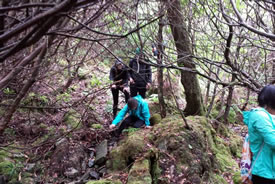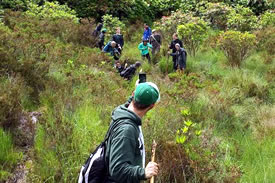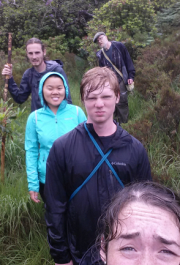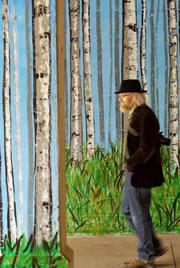#1000 Urban Miles: An Invitation to walk in the Praeger spirit

Killarney (Photo by Emily Walsh)
It’s possible that you don’t know what walking is, what walking can accomplish, until you have walked a distance across a mountainy bog in Ireland. In the rain.
Earlier this summer, accompanied by a colleague and by 14 of our students from DePaul University in Chicago, I followed in the footsteps of the great Irish naturalist and walker Robert Lloyd Praeger (1885-1953). Praeger, an amateur naturalist and one-time Head Librarian of Ireland’s National Library, traversed Ireland in the late 19th and early 20th centuries mapping the vegetation of that moist and verdant island. More than 60 years after his death he remains Ireland’s most influential botanist; an influence that derives not only the prodigiousness of his output (over 800 scientific papers and articles and 24 books) but in his advocacy for the basic methodology of the naturalist’s trade: walking. He hiked on foot across the countryside looking for hidden marvels.
Our hiking this summer along Praeger’s routes culminated in a trailless hike in the western park of Killarney National Park, a 102.9-square-kilometre reserve of wooded and boggy mountainside. Accompanied by park educator Chris Barron we took boats across the famous Lakes of Killarney and commenced our walk by leaping from the vessels as far as we could across the ooze where the bogland met the water. Only one one of the students lost footwear, and as we retrieved the boots from the slime she hopped onto only slightly more secure ground.

Killarney hike (Photo by Emily Walsh)
The walk wound up along a valley adjacent to the peak of the Eagle’s Nest Mountain. No eagles existed there for over one hundred years until white-tailed eagles were re-introduced to the park in 2007. This day we were greeted by a peregrine falcon who bolted out from the peak and into a stone-gray sky. We walked on through the lovely, though rarely visited, Eamonn’s Woods. Here oaks hunker down like resting giants surveying lonely terrain. We broke for lunch in a small landscape called Glaisín na Marbh, a name that translates, somewhat terrifyingly, as "little stream of the dead." It is so called because the few families that lived at the base of the stream died off during the Great Famine (1845-49). There is an unmarked famine grave in the vicinity, which may now be covered in a pavement of scree that tumbled down when the stream was in winter riot the year before. It says something about the remoteness of the region that the ground was not consecrated until more recent times when a priest made the hike into this part of the National Park.
The rain that had been a drizzle — a classic Irish “soft day” — when we commenced the climb now descended in impressive sheets. The little stream gurgled beside us. We hunched on boulders beneath the oaks and ate our sandwiches. The rain found us where we sat. If any of my students had been wondering about the Irish ancestral experience this might have been it: eating cold food under dripping hedges on boggy ground. A student made a short video of our arduous descent to the boats; the highlight of the clip is a feeble yell for “help” as one by one the kids tumbled on saturated soil and into the gorse, a shrub that is less lovely when its thorny shoots impale you than it is from afar. It did not surprise me, however, that several of the more robust students declared this their favorite hike of our visit.
This was hiking in the Praeger spirit — he perhaps had been more prolific on the topic of walking in the rain than any other writer. Even his late autobiographical volume A Populous Solitude (1941) he devoted a portion of the concluding chapter to walking in “a cascade of rain.” He recounted some of his favorite soakings. Once on Achill Island in Co Mayo, Praeger reported that he, “met rain like a waterspout.” Fortunately this was followed by, “such a glorious drying sun and wind that, having been washed to the very bones, I have returned as dry as I started.” He was not always so fortunate, and once described a “grand scramble” with three friends on Croaghaun, a mountain also in Co Mayo, where “the heavens opened and fairly submerged” the party. Determining that they would not meet their destination without having “reached and passed the point of complete saturation” the friends “trudged down at leisure through the drenched heather.”
In his earlier, and more comprehensive, account of his rambles in Ireland entitled The Way That I Went, a volume that has been almost continuous in print since it was first published in 1937, Praeger prefaces his account of Ireland’s natural wonders with tips on practical matters concerning walking in “an amphibious kind of land” such as Ireland. “The whole west coast,” he wrote, “is a country redolent of wind and rain, with an atmosphere that recalls blue eyes with tears in them.”

Killarney hike (Photo by Emily Walsh)
Beautiful as that may be there are practical matters to consider: how best to equip oneself for blustery Irish days when one is off on the hoof? In addition to the likelihood of getting caught out in a downpour, Praeger was also mindful here of the many streams, rivulets, ponds and so forth that the botanist must cross in surveying the countryside. In response to such conditions, one should, “wear shoes with holes in them to let the water out,” though he conceded that to be submerged waist deep “is distinctly inconvenient.”
Praeger retells a story in The Way I Went that is still told in Irish botanical circles — I heard it during a lecture by that more contemporary British botanist David Bellamy — about two rival naturalists walking in torrential rain in County Wicklow. One of them deliberately walked through the briars by a riverside “so as to discourage his rival.” The rival upped the ante, and proved his indifference to the moisture by walking into the river, where he “sat down on a submerged stone and began to eat lunch.” Then the first botanist, “with the utmost nonchalance and without saying a word did likewise.”
Rather than worrying about the weather Praeger would sooner have us “poking our noses, like terriers, into every hole, be it dry or wet.” Thus I suspect that Praeger would have been somewhat proud of my drenched, floundering, but doggedly persistent students.
There is however, as we have seen, a pinch of aesthetics in Praeger’s appreciation of walking in Ireland — an appreciation for the teary-eyed skies of the West. Above all, however, Praeger was a practical man. Thus his “philosophy of walking,” if we can call it this, was at the service not of merely strolling to pretty places, but for the purposes of mapping the vegetation of Ireland. For the purposes of assembling material for his volume Irish Topographical Botany (1901), which provided note on the distribution of plants through out the island, he estimated that it needed 50 days in the field for each of five consecutive years, each day of which consisting of 12 hours in the field, traversing 20-25 miles of diverse ground.
Thus in the last five years of the 19th century Praeger walked 1,000 miles a year, each year!
Walking for the naturalist is methodology and not merely conveyance. But like all methodologies this one requires some careful consideration, some refinement and some practice. Praeger gave the matter some consideration. The essence of walking as a naturalist is to neither head for nor avoid picturesque spots. The field botanist, wrote Praeger, “ranges far over hill and dales, though there is good ground and bad ground, he never knows where an interesting or rare plan may not be concealed.” It is not unlikely that the botanist makes her best discoveries at the end of the day, even, perhaps, outside her accommodations as she returns from her labours.
The results of five years of deliberate “rambling” around Ireland was botanical information on 600 or so species for each of the 40 regional divisions of Ireland. Just as importantly for Praeger, at least, it resulted in “extensive and intimate knowledge…of all those parts of Ireland which, being reckoned uninteresting, are to the majority of people unknown.” Tramping 5,000 miles across Ireland in his early years “equalized” his knowledge of the country: he became just as acquainted with the immediately attractive areas and those less familiar. As a matter of practicality Praeger routinely took the train, getting off at chosen points and walking to the next station. Walking accomplished the outcome of intimacy in a way that cars can not. Admittedly during the years that Praeger was preparing Irish Topographic Botany (1896 - 1900) cars were a rarity in Ireland. Nonetheless, Praeger’s objection to the car was a simple one. The car, he wrote, “travels too fast for the serious observer.” For those whose minds are “jaded by with the meaningless noise and hurry of modern life…quiet wandering on foot along brown streams and among the windy hills can bring a solace and a joy that is akin only to the peace of God that passeth understanding.”
In early 2013 I spent a week or so in the Praeger Archives at the Royal Irish Academy in Dublin. There are 10 boxes of material in addition to collections of photographs taken mainly by Robert Welch (1859–1936) illustrating many of the sites Praeger wrote about. There, surrounded by the flotsam of a productive life, the hand-written manuscripts, the hundreds of reprints, the minutes of meetings of the august scientific bodies which he oftentimes led, his Zenith watch, letters from fellow naturalist, notifications from landlords and so forth, I became aware of a simple fact that should have been obvious to me before this, though embarrassingly it was not.
The neglected fact: although Praeger spend those weeks every year in the field, marching across boggy ground in the rain, nonetheless, as he later wrote “being the finite and worldly creatures that we are, we cannot exist long on that high plain.” Thus Praeger spent most of his life in Dublin, which was even back then a bustling city (about a quarter of a million people in Praeger’s time). It is worth noting as an aside, that in those more leisurely times, he was permitted to devote himself to Irish botany although his official position was with the National Library.
Like many naturalists of his time Praeger lived in a city, but quite unlike most of them he took a lively interest in the urban environment. He published papers on plants found in parks in Dublin, including some records in the park I grew up beside in Terenure, a suburb of the city. He also included a superb account of the natural history of Dublin city in The Way that I Went.
After my visit to the archive I returned to Chicago, where I teach and research on topics primarily related to urban biodiversity conservation. I resolved to do some walking of my own, but in the Praeger spirit. Praeger’s distance of 1,000 miles a year seemed like the appropriate distance, but instead of heading out of town, as he often (though not always) did, I would concentrate them on walking in the city — after all one finds the most surprising marvels in the most unlikely of places.
Since I started this odyssey in 2013, and started tweeting about it using #1000UrbanMiles, a number of friends, colleagues started on the Praeger Challenge with me. Word got around and now there are several people across the U.S. and some in Europe following in his footsteps.
I am not especially interested in dictating a set of strict qualifying requirements to my fellow walkers, so those who are engaged in the #1000UrbanMile project are each proceeding according to their own interests. The Praeger spirit simply implies an openness to seeing new things. To walk in this spirit is simple enough in theory. One should walk attentively, neither avoiding picturesque spots nor heading for them either. In my own practice I do not listen to music as I walk, I put away my phone (though I tweet about the walk afterward!). I try not as I walk to get embroiled in thoughts of work. In my walking I am primarily concerned with concern itself; I walk, look, record.
The challenge of walking after Praeger is not just to see new things but to see with a refreshed spirit, a receptive mind. I invite you to join. If you are interested in learning more details and connecting with the community of Praeger walkers feel free to contact me at lhenegha [at] gmail [dot] com.


